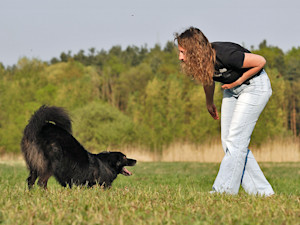Dogs Understand Us Better When We Speak Slowly, Study Finds
If you can’t get your pup’s attention, try slowing down.

Share Article
You’ve probably already noticed that there are some messages your dog gets loud and clear, while others seem to go right over their perfect little heads. They might stare at you blankly during your breathless explanation of the plot of The Bear, but they seem to know exactly who is such a good doggie. Now, scientists are getting to the bottom of how we can better communicate with our dogs. A new studyopens in new tab published in PLOS Biology found that dogs understand slow speech better than fast speech — meaning the next time you’re chatting with your pup, you might want to channel Christopher Walken rather than Katharine Hepburn.
How dog and human speech patterns differ
Researchers analyzed the vocal sequences of 30 dogs — all their barks, growls, howls, snarls, and whines. They also analyzed the speech patterns of 27 humans speaking to other humans across five languages, plus 22 humans speaking to dogs across five languages. They found that dogs vocalize more slowly than humans; while humans speak about four syllables per second, dogs vocalize at a rate of about two sounds per second.
They also found that when speaking to dogs, humans tended to speak at a slower rate than when speaking to humans — but still a faster rate than when dogs speak to each other. On average, people lower their speech rate to about three syllables per second when addressing pups.
How dogs best understand speech
The researchers then performed EEGs on dogs and humans to measure their neural activity. They found that dogs best process delta rhythms, which relate to the long, slow rhythms in speech like intonation and pauses. Humans, though, prioritize processing theta rhythms — the faster parts of speech, like individual syllables.

Dogs are not able to process the quick, intricate parts of our sentences, but they can get the gist when we take it slow. This means that our instinct to slow down our speech when we’re talking to our pups is right, but we could even take it one notch further. The researchers hope that this knowledge can help promote stronger bonds between people and dogs. After all, our dogs are ready to listen — they just want us to take our time.

Sio Hornbuckle
Sio Hornbuckle is the Assistant Editor at Kinship, where they frequently write for the site. As a writer, they specialize in pet news, animal science, and pop culture. They live in New York City with their cat, Toni Collette.
Related articles
Can Your Dog Tell When You’re Lying?
They can sniff out where you’ve hidden their treats, but deception is another matter.
![Woman holding her small black dog with his favorite toy.]()
Dogs Can Remember Names of Toys 2 Years After Seeing Them, New Study Finds
Some dogs have impressive long-term memories.
![]()
To Cry Is Human—and Apparently Canine
Time to whip out The Notebook for a little doggie movie night.
Why Does My Dog Sit on Me?
“If I fits, I sits.”
![a dog doing a play bow with their human parent]()
6 Ways Your Dog Is Signaling They Want to Play—Right Now
Your dog knows when they want fun and games, but it’s important you understand. Here’s why.
![Woman teaching her dog how to use speech buttons.]()
Dogs Really Do Understand Speech Buttons, New Study Finds
Those viral Tiktok videos may not be all smoke and mirrors.






